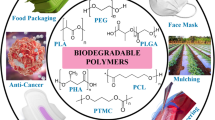Abstract
Purpose. To develop a qualitative method for the determination of the mode of scission in the hydrolysis of biodegradable polymers.
Methods. The method requires determination of the molar fraction of monomer (m1 by 1HNMR or HPLC, and the degree of polymer degradation (α) determined by 1HNMR.
Results. If the scission of the backbone bonds is completely random, the molar fraction of the monomer must equal the square of the degree of degradation as predicted by Kuhn (1). If the degradation follows an exclusive chain-end “unzipping” mechanism then, m1 = α. Experimental data falling on the theoretical curves (m1 vs. α) confirm the corresponding mode of scission. If the data fall between the two curves, it suggests a faster chain-end scission than random scission. When data fall below both of these curves, it suggests the chain-end bonds are less reactive than the internal bonds.
Conclusions. The acid catalyzed hydrolysis of a poly(ortho ester) and the base catalyzed hydrolysis of poly(D,L-lactide) (PLA) were by a random scission mechanism, while acid catalyzed hydrolysis of PLA demonstrated faster chain-end scission.
Similar content being viewed by others
REFERENCES
W. Kuhn. Über die kinetik des abbanes hochmolekularer ketten. Ber. 63B:1503–1509 (1930).
M. Chasin and R. Langer. Biodegradable polymers as drug delivery systems, Marcel Dekker, Inc. New York, N.Y. 1990.
N. S. Mason, C. S. Miles and R. E. Sparks. Hydrolytic degradation of poly(D,L-lactide). In Gebelein and Koblitz (eds.), Biomedical and Dental application of polymers, Plenum Press, New York, NY (1981), pp. 279–291.
C. Pitt. Poly(ε-caprolactone) and its copolymers. In M. Chasin and R. Langer (eds.), Biodegradable polymers, Marcel-Dekker, New York, New York (1990), pp. 97–103.
R. A. Kenley, M. O. Lee, T. R. Mahoney, II, and L. M. Sanders. Poly(lactide-co-glycolide) decomposition kinetics in vivo and in vitro. Macromolecules 20:2398–2403 (1987).
H. H. G. Jellinek, Degradation and depolymerization kinetics. In H. H. G. Jellinek (ed.), Aspects of degradation and stabilization of polymers, Elsevier Scientific of Publishing Company, New York, 1978, pp. 1–38.
P. J. Flory. Principles of Polymer Chemistry, Cornell University Press, London, 1953, pp. 83–86.
C. Shih. Chain-end scission in acid catalyzed hydrolysis of poly(D,L-Lactide) in solution. J. Controlled Release, 34:9–15 (1995).
J. Heller, D. W. H. Penhale, and R. F. Hewlwing. Preparation of poly(ortho ester)s by the reaction of ketene acetals and polyols. J. Polym. Sci., Polym. Lett. Ed. 18:82–83 (1980).
K. E. Heppert, W. R. LaCourse and R. D. Shaffer. HPLC with pulsed amperometric detection of diols from the degradation of poly(ortho ester)s. Presented at the meeting of the American-Chemical Society, April, 1992, San Francisco, CA.
Rights and permissions
About this article
Cite this article
Shih, C. A Graphical Method for the Determination of the Mode of Hydrolysis of Biodegradable Polymers. Pharm Res 12, 2036–2040 (1995). https://doi.org/10.1023/A:1016276830464
Issue Date:
DOI: https://doi.org/10.1023/A:1016276830464




